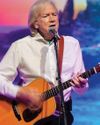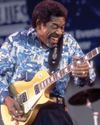
GT: What is it about guitar instrumentals that appeals to you?
SH: As I am a guitarist first and foremost, guitar based compositions will always be of interest. If you look at the history of music you will find that a high proportion is in fact instrumental-based rather than featuring a singer. The guitar can be used both for melodic lines and for chordal accompaniment, and so it can be used in a variety of ways to create instrumental compositions and evocative parts.
GT: What can an instrumental provide a listener that a vocal song can't?
SH: The human voice is a primary way of communicating emotion in music, plus the use of words brings an additional dimension of artistic experience. But non-vocal musical instruments can also convey emotion in both a subtle and an emphatic way, with other possibilities of abstract musical expression that are perhaps limited by the more blatant use of vocals. Orchestral symphonies are by definition instrumental and so non-vocal.
GT: Any tendencies that you embrace or avoid?
SH: The only thing I would seek to avoid is blandness or cheesiness. I wouldn’t avoid musical clichés, per se, as sometimes the use of cliché can make a statement in itself. But it has to be done in a cool way. Are there any set rules as to what is cool? Not really, it’s essentially an intuitive thing.
GT: Is a typical song structure always relevant for an instrumental?
SH: It can be relevant for an instrumental, but it most certainly doesn’t have to be like that. Instrumentals are more about themes and motifs than about verses and choruses.
Esta historia es de la edición Spring 2023 de Guitar Techniques.
Comience su prueba gratuita de Magzter GOLD de 7 días para acceder a miles de historias premium seleccionadas y a más de 9,000 revistas y periódicos.
Ya eres suscriptor ? Conectar
Esta historia es de la edición Spring 2023 de Guitar Techniques.
Comience su prueba gratuita de Magzter GOLD de 7 días para acceder a miles de historias premium seleccionadas y a más de 9,000 revistas y periódicos.
Ya eres suscriptor? Conectar

THE MOODY BLUES
This month Stuart Ryan delves into the picking style of this British prog legend whose acoustic guitar has powered many a Moody Blues song.

WAYNE KRANTZ
This issue Nick Mellor provides an insight into this brilliant jazz stylist, focusing on his approach to improvising over static chords.

OPEN G TUNING
Open tunings are great fun and can help create exciting new ideas. Simon Barnard shows how to incorporate open G tuning into your playing.

RODRIGO GOUVEIA
Last month we featured Mateus Asato, and mentioned the importance of the neo-soul style in his playing. Here we turn to his fellow Brazilian, the master of neo-soul fusion.

MARK KNOPFLER
Our topic this month is a master craftsman as both guitar player and songwriter. His style is unique and his influence spreads far and wide.

U2
Martin Cooper checks out the chiming pedal delay tones of this stadium-filling band from Dublin, Ireland, and guitarist The Edge.

LUTHER ALLISON
It’s blues with a touch of soul this month, as David Gerrish explores the dynamic, expressive style of an often overlooked Chicago bluesman.

JOHANN KASPAR MERTZ Capriccio
This month Declan Zapala explores the music of Austria at the turn of the Romantic period with a fiery caprice to level up your fingers and unlock your inner virtuoso.

THE CROSSROADS Michael Landau
John Wheatcroft explores the playing of a session ace _ and blazing blues-rock maestro who graces the top-flight m band of singer-songwriting legend, James Taylor.

VIDEO MASTERCLASS Troy Redfern
This month GT welcomes this slide guitar virtuoso. If you've been wanting to take your slide playing to the next level then this is one's for you. With Jon Bishop.